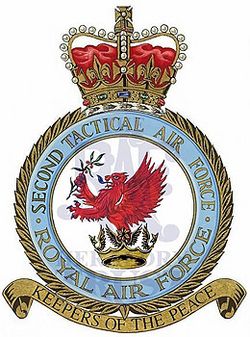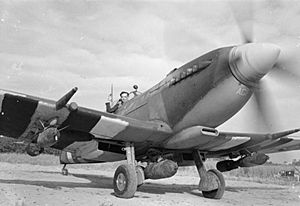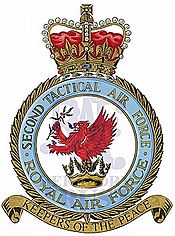RAF Second Tactical Air Force facts for kids
Quick facts for kids RAF Second Tactical Air Force |
|
|---|---|

Badge of the Second Tactical Air Force
|
|
| Active | June 1943 – July 1945 September 1951 - 1 January 1959 |
| Country | |
| Branch | |
| Type | tactical air force |
| Role | air superiority and support ground offensive |
| Motto(s) | Keepers of the peace |
| March | Royal Air Force March Past |
| Insignia | |
| Badge | Winged demi-lion above an astral crown grasping an olive branch |
The RAF Second Tactical Air Force (2TAF) was an important part of the Royal Air Force (RAF). It was one of three special air forces used during and after the Second World War.
This force included pilots and teams from the RAF. It also had members from other British Commonwealth air forces. Even exiles from parts of Europe controlled by Germany joined. In 1945, it was renamed the British Air Forces of Occupation. Then, in 1951, 2TAF was started again. Finally, in 1959, it became Royal Air Force Germany.
Contents
How the RAF Second Tactical Air Force Started
The 2TAF was officially formed on June 1, 1943. It began as the HQ Tactical Air Force. This happened as plans were being made to invade Europe the next year.
The new force brought together units from both Fighter Command and Bomber Command. Its main job was to support the Army on the battlefield. Bomber Command provided No. 2 Group with light bombers. Fighter Command was split into different parts.
One part, the Air Defence of Great Britain, kept fighter planes for defending the UK. Other parts, like No. 83 Group and No. 84 Group, flew aircraft. No. 85 Group managed ground-based units for the Second Tactical Air Force. Also, No. 38 Group helped by towing assault gliders. No. 140 Squadron, which did photo-reconnaissance, was also part of 2TAF from the start.
The Second World War and 2TAF's Role
The first leader of 2TAF was Air Marshal Sir John d'Albiac. On January 21, 1944, he was replaced by Air Marshal Sir Arthur Coningham. Coningham is the person most linked with the Second TAF.
Coningham had a lot of experience supporting fast-moving ground battles. He had led the Desert Air Force in North Africa and Italy. He made the Second TAF very strong and ready for its challenges. He used many lessons from Italy, like the "cab rank" system for aircraft. This system helped planes provide quick close air support to ground troops.

No. 34 (Photo Reconnaissance) Wing helped with air spotting for naval gunfire support during Operation Overlord. This wing included several squadrons from different countries. These were No. 2 Squadron RAF, No. 26 Squadron RAF, No. 63 Squadron RAF, No. 268 Squadron RAF, No. 414 Squadron RCAF, 808 Naval Air Squadron, 885 Naval Air Squadron, 886 Naval Air Squadron, 897 Naval Air Squadron, and briefly, the United States Navy's VOS-7.
By the end of the war, the German air force, the Luftwaffe, was much weaker. Most of the time, the Second TAF supported British and Canadian forces. These forces were on the left side of the Supreme Headquarters Allied Expeditionary Force's command.
One big event was the Luftwaffe's last major attack, Operation Bodenplatte. This happened on New Year's Day in 1945. During this attack, the Second TAF lost many planes and people on the ground.
On January 20, 1945, four Gloster Meteor jets from 616 Squadron moved to Melsbroek in Belgium. They were then attached to the Second Tactical Air Force. In February 1945, No. 87 Group RAF was created to handle transport. It became part of 2nd TAF/BAFO.
After the Second World War
The Second TAF was renamed the British Air Forces of Occupation on July 15, 1945. It started as a large force with four groups. However, No. 2 Group was disbanded on May 1, 1947.
By the end of 1947, the force had become much smaller. It had only ten squadrons at three airfields. These were all directly controlled by the Air Headquarters at Bad Eilsen. In 1951, the British Air Forces of Occupation went back to its old name. The Second Tactical Air Force was re-created on September 1, 1951.
No. 2 Group was again transferred to the Second Tactical Air Force on September 1, 1951. But it was disbanded on November 15, 1958. No. 83 Group RAF controlled 2TAF's southern area from 1952 to 1958.
On July 1, 1956, No. 2 Group included several wings. These were at Ahlhorn, RAF Fassberg, Gutersloh, Jever, Laarbruch, RAF Oldenburg, and RAF Wunstorf. At the same time, No. 83 Group managed wings at RAF Bruggen, Celle, RAF Geilenkirchen, RAF Wahn, and RAF Wildenrath.
The Second Tactical Air Force was renamed Royal Air Force Germany on January 1, 1959. At this point, the Commander-in-Chief of RAF Germany also became the commander of the NATO Second Allied Tactical Air Force (2 ATAF).
Who Led the Second Tactical Air Force?
Here are the commanders who led the Second Tactical Air Force and its later names:
Second Tactical Air Force Leaders (WWII)
- June 1, 1943: Air Marshal Sir John D'Albiac
- January 21, 1944: Air Marshal Sir Arthur Coningham
British Air Forces of Occupation Leaders
- July 15, 1945: Air Chief Marshal Sir Sholto Douglas
- February 1, 1946: Air Marshal Sir Philip Wigglesworth
- October 30, 1948: Air Marshal Sir Thomas Williams
Second Tactical Air Force Leaders (Post-WWII)
- October 1, 1951: Air Chief Marshal Sir Robert Foster
- December 3, 1953: Air Marshal Sir Harry Broadhurst
- January 22, 1956: Air Marshal The Earl of Bandon
- June 1, 1957: Air Marshal Sir Humphrey Edwardes-Jones
Royal Air Force Germany Leaders
- January 1, 1959: Air Marshal Sir Humphrey Edwardes-Jones
- January 7, 1961: Air Marshal Sir John Grandy
- June 25, 1963: Air Marshal Sir Ronald Lees
- December 6, 1965: Air Marshal Sir Denis Spotswood
- July 16, 1968: Air Marshal Christopher Foxley-Norris
- November 10, 1970: Air Marshal Harold Brownlow Martin
- April 4, 1973: Air Marshal Nigel Maynard
- January 19, 1976: Air Marshal Sir Michael Beetham
- July 25, 1977: Air Marshal Sir John Stacey
- April 30, 1979: Air Marshal Sir Peter Terry
- February 2, 1981: Air Marshal Sir Thomas Kennedy
- April 9, 1983: Air Marshal Sir Patrick Hine
- July 1, 1985: Air Marshal Sir David Parry-Evans
- April 13, 1987: Air Marshal Sir Anthony Skingsley
- April 14, 1989: Air Marshal Sir Roger Palin
- April 22, 1991: Air Marshal Sir Andrew Wilson
More to Explore
- RAF First Tactical Air Force
- RAF Third Tactical Air Force
- List of Royal Air Force commands


